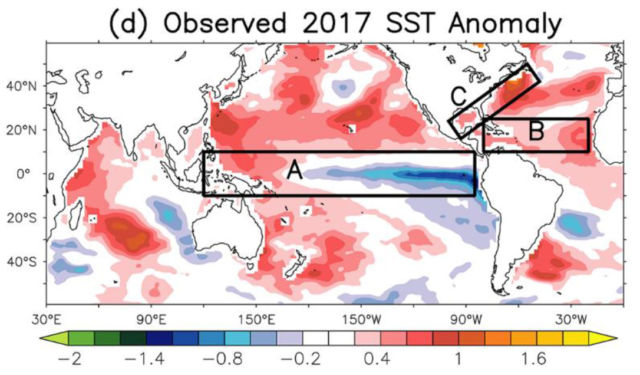A lot of people who would rather forget the 2017 Atlantic hurricane season, and many are no longer alive because of it. Hurricanes Harvey, Irma, and Maria were all destructive when they made landfall, and three other major hurricanes (Category 3 or stronger) mercifully spun out their lives over the ocean. In an average year, the Atlantic sees 2.7 major hurricanes—six is highly unusual.
The birth and life of tropical cyclones in a flowing, churning atmosphere is amazingly complex. But by looking at the past, weve learned there are certain ocean patterns that tend to boost or dampen a hurricane season. To investigate the factors responsible for 2017s hurricane season, a team led by NOAAs Hiroyuki Murakami leaned on that knowledge, together with climate model experiments.
Forecase models
North Atlantic hurricanes are born just above the equator as a low-pressure center. As that low pressure moves westward with the prevailing trade winds, it can continue to organize into a strong cyclone if it has a warm sea surface and if the winds aloft are mild enough to allow the storm to grow upwards.
Sea-surface temperatures in the area where hurricanes are born are obviously important, and there are a couple Atlantic Ocean oscillations that can push these temperatures above or below normal. Those upper winds can also be above or below normal strength for a couple reasons. Sea-surface temperatures right along the US East Coast seem to have an effect, with warmer temperatures making for stronger winds. The year-to-year El Niño/La Niña ocean temperature seesaw in the Pacific also plays an important role here, with stronger upper winds inhibiting hurricane development in El Niño years.
To test these different factors individually, the researchers used the same high-resolution NOAA model that produces a forecast of hurricane activity at the start of the season. In a series of experiments, the researchers tweaked temperatures in one region or another to observe the effect on simulated hurricanes for the rest of the year.
If the global sea surface temperature pattern is set to the average from 1982-2012, the model simulates about three major hurricanes—no surprise there. Starting with the actual temperature pattern from early July 2017, the model correctly simulates about six major hurricanes instead.
Whats key?
Taking the 2017 temperatures and replacing one region at a time shows some interesting results. Replacing the La Niña pattern in the Pacific—which typically boosts hurricane activity—with an El Niño only had a minor impact. Switching out the Atlantic's warm temperatures with the longer-term average, on the other hand, reduced the number of major hurricanes from six to about four. So it seems the Atlantic bears more responsibility than the Pacific, in this case.
The researchers also tried replacing just the area along the US East Coast that can affect the upper winds, but this actually didnt reduce the number of major hurricanes. Replacing just the tropical area of the Atlantic where these hurricanes are born, however, did. That narrows it down even more.

Finally, the researchers took a look at the effect of global warming. Using medium and high greenhouse-gas-emissions scenarios, they added our expected warmer ocean temperatures to either 2017s pattern or the longer-term average. In either case, the model simulated even more major hurricanes. When 2017s spatial pattern of temperatures was used as the base, its six major hurricanes rose to eight or nine.
In the end, the studys conclusions are a little tricky. The biggest factor in the 2017 Atlantic hurricane season seems to have been elevated ocean temperatures in the tropical region where hurricanes first form. Answering why the water was especially warm there is where things get murky. The multiple back-and-forth patterns of natural variability in the Atlantic probably contributed. But it could be that human-caused warming also contributed—this study cant assign fractions of blame there.
Climate scientists have a number of general expectations (generally bad news) for future tropical cyclones around the world, but highly specific questions (like whether we will see active Atlantic hurricane seasons more often) are more unclear. Several moving parts have to be pinned down before you can see what their net effect is.
The continental US enjoyed a lucky streak without a major hurricane making landfall between 2006 and 2016—a streak that 2017 rudely snapped. Analysis in the wake of 2017s hurricane season can further researchers understanding of these deadly storms, gradually giving us a better idea of how theyll respond to our continued warming of the planet.
Science, 2018. DOI: 10.1126/science.aat6711 (About DOIs).
[contf] [contfnew] 
Ars Technica
[contfnewc] [contfnewc]







